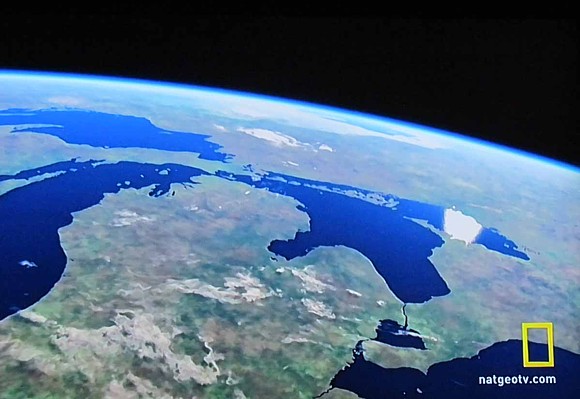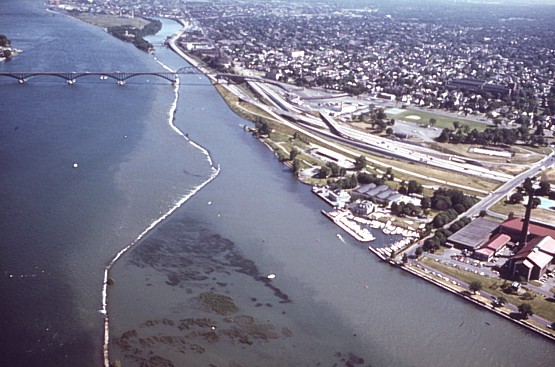Buffalo To Reduce Lake Erie Pollution With Grant from the Great Lakes Restoration Initiative
 April 2, 2014
April 2, 2014  Kyriaki (Sandy) Venetis
Kyriaki (Sandy) Venetis The U.S. Environmental Protection Agency has awarded the City of Buffalo, NY, a $500,000 grant from the Great Lakes Restoration Initiative (GLRI) that will be used in conjunction with another $500,000 in funding from Empire State Development to provide green infrastructure in an effort to minimize polluting stormwater runoff into Lake Erie.
 Space view of the Great Lakes.
Space view of the Great Lakes.
Empire State Development is New York State’s chief economic development agency that works to promote the growth of the state economy through loans, grants, tax credits, and other forms of financial assistance to projects and initiatives that will create business growth and job creation.
A major focus of this project will be building a green infrastructure along a one-mile stretch of Buffalo’s Niagara Street that’s part of the Great Lakes Seaway Trail and National Scenic Byway. This area currently accumulates untreated stormwater that drains directly into the Black Rock Navigation Channel and the Niagara River.
 Northern waterfront of the Niagara River. Photo from Wikimedia.org.
Northern waterfront of the Niagara River. Photo from Wikimedia.org.
The EPA says the project will include the installation of porous asphalt, stormwater planters, rain gardens, and the reduction of impervious pavements. The new project is expected to capture stormwater from about 15 acres along Niagara Street and result in the reduction of about 5 million gallons of stormwater runoff per year.
The EPA expects that the new green infrastructure will result in “a significant reduction in the amount of road salts, nutrients, oil and grease, and sediment flowing into the Niagara River.”
Buffalo is one of the 16 cities to receive funding in the initial round of the EPA’s new GLRI Shoreline Cities grant program. These grants are designed to support the improvement of water quality in the Great Lakes basin, and can be used to fund up to 50 percent of the cost of green infrastructure projects on public property.
The GLRI was launched at the start of the Obama administration to coordinate federal agencies to work together to protect and restore the Great Lakes, with about $6 million allocated for the overall initiative.
These projects are important for the physical as well as economic health of the region. The EPA estimates that, “Some 30 million Americans get their drinking water from the Great Lakes, and the lakes also support a multi-billion dollar economy based on fishing, boating, and recreation activities.
The GLRI is working on the following five objectives:
- Cleaning up heavily polluted areas of the Great Lakes region.
- Combating invasive species.
- Protecting watersheds from polluted runoffs to improve the health nearshore bodies of water.
- Restoring wetlands and other habitats.
- Tracking progress and providing education.
This year, the areas of greatest concern that are being focused on for toxic cleanup are several Michigan water bodies, including: Deer Lake, Manistique River, St. Clair River, and St. Marys River. In Illinois, Waukegan Harbor will also be a major focus of the cleanup.
Another priority this year is reducing the harmful levels of algae in three priority watersheds – the Lower Fox River in Wisconsin, the Saginaw River in Michigan, and the Maumee River in Ohio.
Scientists working on the GLRi have found that high levels of algae can choke aquatic life and create dead zones devoid of oxygen. These dead zones also hurt local fishing and tourism economies, as well as put human health at risk.
These dead zones are largely found in nearshore bodies of water, and are largely contaminated by sediments and other pollutant including fertilizers containing phosphorus runoffs. Algae feed on phosphorus, nitrogen, and other nutrients, which leads to those large slimy blooms that we see.
The green infrastructure plans scheduled for Buffalo’s Niagara Street are among the strategies being promoted by the GLRI to combat pollutants, including agricultural, from entering the Great Lakes basin.
Additional Resources
Reader comments and input are always welcomed!

Reader Comments